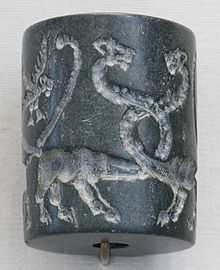Uruk period
 | |
| Geographical range | Mesopotamia |
|---|---|
| Period | Copper Age |
| Dates | c. 4000–3100 BC |
| Type site | Uruk |
| Preceded by | Ubaid period |
| Followed by | Jemdet Nasr period |
Part of a series on the |
|---|
| History of Iraq |
| Ancient Iraq |
| Classical Iraq |
| Medieval Iraq |
| 20th-century Iraq |
| Republic of Iraq |
| Iraq portal |
The Uruk period (ca. 4000 to 3100 BC) existed from the protohistoric Chalcolithic to Early Bronze Age period in the history of Mesopotamia, following the Ubaid period and succeeded by the Jemdet Nasr period.[1] Named after the Sumerian city of Uruk, this period saw the emergence of urban life in Mesopotamia. It was followed by the Sumerian civilization.[2] The late Uruk period (34th to 32nd centuries) saw the gradual emergence of the cuneiform script and corresponds to the Early Bronze Age; it may also be called the Protoliterate period.[3] It was during this period that pottery painting declined as copper started to become popular, along with cylinder seals.[4]
History of research
The term Uruk period was coined at a conference in Baghdad in 1930, where at the same time the Jemdet Nasr and Ubaid periods were defined.[5]
Dating and periodization
Periodization is after archaeological layers at Uruk. Thus, Uruk XVIII–XIV are not part of the "Uruk period" proper but are comprised by the Ubaid period. The Uruk period proper corresponds to the layers Uruk XIV–IV, with the late phase Uruk IV lasting ca. 3300–3100 BC. Uruk III reaches up to 3000 BC and into the Early Dynastic period .
Early city-states

These early city-states had strong signs of government organization (though social stratification was not strongly evident until very late in this period and the beginning of the Early Dynastic Period, beginning around 3100 BC), evident even in items such as cheap, mass-produced beveled rim bowls which were made to be discarded. These bowls may have been handed out at community outings, such as large-scale constructions. The cities grew to cover up to 250 acres (1 km²) and support up to 10,000–20,000 people by the end of the period.
End of the Uruk period
A few commentators have associated the end of the Uruk period with the climate changes linked to the Piora Oscillation, an abrupt cold and wet period in the climate history of the Holocene Epoch,[6] other explanation is the arrival of the East Semitic tribes represented by the Kish civilization.[7]
References
- ↑ Crawford 2004, p. 69
- ↑ Crawford 2004, p. 75
- ↑ As for example in Frankfort 1970, where the first chapter covers the period.
- ↑ Langer 1972, p. 9
- ↑ Matthews, Roger (2002), Secrets of the dark mound: Jemdet Nasr 1926-1928, Iraq Archaeological Reports 6, Warminster: BSAI, ISBN 0-85668-735-9
- ↑ Lamb 1995, p. 128
- ↑ Lucy Wyatt. Approaching Chaos: Could an Ancient Archetype Save C21st Civilization?. p. 120.
Sources
- Crawford, Harriet E. W. (16 Sep 2004). Sumer and the Sumerians (2nd ed.). Cambridge University Press. ISBN 9780521533386.
- Frankfort, Henri (1970). The Art and Architecture of the Ancient Orient. Pelican History of Art (4th ed.). Penguin. ISBN 0140561072.
- Lamb, Hubert H. (1995). Climate, History, and the Modern World. London: Routledge. ISBN 0-415-12735-1.
- Langer, William L., ed. (1972). An Encyclopedia of World History (5th ed.). Boston, MA: Houghton Mifflin Company. p. 9. ISBN 0-395-13592-3.
See also
| |||||||||||||||||||||||||||||||||||||||||
| ||||||||||||||||||||||
